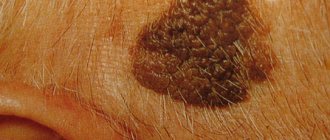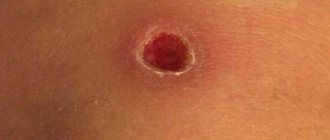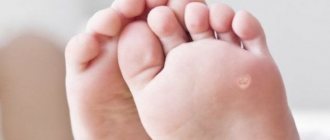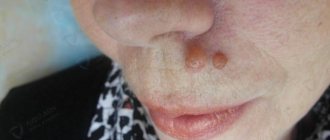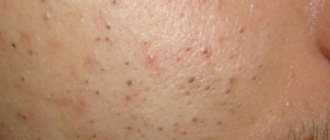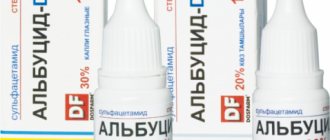Reasons for appearance
Condyloma, papilloma or wart on the eye are overgrown skin cells covered with a layer of keratinized epithelium. They are most often caused by the human papillomavirus (HPV). According to statistics, 70-90% of the population are carriers of papillomavirus. It can live in the body for many years and become more active due to decreased immunity, manifesting itself in the form of formations on the skin.
A large number of tumors on the body signals the presence of the human papillomavirus or HPV. In the absence of comprehensive treatment, the disease progresses, resulting in even more growths.
Infection with the virus occurs as a result of bodily and physical contact with its carrier during handshakes, use of personal belongings of an infected person, and even during childbirth, when the infection is transmitted to the child from the mother. After entering the body, viruses remain in the skin cells and are activated under favorable conditions. These may include minor skin injuries, hypothermia, a weakened immune system, and exposure to irritants.
Varieties
A wart on the eye can have different locations. There are growths on the lower or upper eyelid, in its corners or on the eyelash line. Most often, formations are localized on the skin of older people in the form of small clusters of papillomas, which look different depending on the type. The type of formation can be determined by the area in which the compaction appears. The list of varieties includes formations of the following types:
- pointed papillomas, the size of which does not exceed 2-3 mm, such growths are flesh-colored or light brown and cone-shaped;
- thread-like formations or acrochords, their sizes vary from 3 to 4 mm, the color of such growths is gray or flesh-colored, their shape is small, long and narrow;
- simple warts on the upper eyelid, capable of growing up to 10-15 mm, deforming the eyelid and affecting vision, their color is flesh-colored or gray.
Removal by surgery
- infection as a result of promiscuity in the absence of barrier protection;
- transmission of infection to the fetus during intrauterine development or during the birth process;
- contact method of infection through common objects.
Often, an infected person may not even suspect the presence of the disease and can infect healthy people for a long time. If the immune system malfunctions in the body, active growth and rapid development of viral cells is observed.
HPV cannot be removed from the body. Pathogenic viruses can be found on clothing, bedding or underwear. An excellent place for pathogens to reproduce and live is a warm and humid environment. Transmission of the virus can occur due to the use of shared hygiene products (towels, washcloths) by several individuals. Elderly people and children are especially at risk of infection.
Why do papillomas appear on the eyelids? Among the many factors that contribute to the activation of the infectious process, the following can be identified:
- constant stress, nervous tension, depression;
- lack of personal hygiene;
- decrease in the body's defenses;
- avitaminosis;
- poor nutrition;
- bad habits;
- pregnancy and lactation;
- hormonal changes in the body;
- taking hormonal tablets;
- chronic diseases;
- eye diseases;
- violation of the secretion of the lacrimal gland.
Formations often develop on the face; papillomas are especially common on the inner and lower eyelids of the eye. In addition to the danger of conjunctivitis and blepharitis, papilloma on the eye can provoke cancer.
In addition to formations localized on the skin of the eyelids, conjunctival papilloma is often found. Tumor-like formations bring some discomfort. Patients often come to the clinic to treat papillomas on the eyelids. It consists of removing them. Only a specialist can determine a specific method. If the papilloma under the eye reaches a significant size, then in addition to inconvenience, it causes the following deviations:
- difficulty closing the eyelids;
- unpleasant sensation of a foreign object in the eye;
- dry mucous membranes;
- itching;
- increased tearfulness;
- redness of the mucous membrane;
- frequent infectious eye diseases (blepharitis, conjunctivitis).
Important! If a papilloma appears in the eye area or on the eyelid, you should immediately consult a doctor for diagnosis and treatment.
Before treating papilloma on the eyelid, it is necessary to determine its type. Depending on the degree of risk of developing cancer, formations can be low-active or highly active.
Low-active growths are practically invisible to the naked eye; they grow slowly, causing virtually no discomfort to the wearer. The formations are flesh-colored or light pink. Removal of papillomas on the eyelids of this type is carried out using conventional methods.
Highly active neoplasms quickly increase in size and can range in color from flesh-colored to dark brown. Sometimes they cause pain and itching. Injuring growths is dangerous due to their degeneration into a malignant form. Treatment of papillomas on the eyelids is carried out strictly according to medical prescription.
Depending on the shape and structure of the growths, the following types are distinguished:
- keratopapillomas are elongated formations, have a rough surface, and can cause pain when touched;
- fibroid – growths that have a dense structure and can take on different shapes and differ in color.
Before removing papillomas on the upper and lower eyelids, it is necessary to undergo a full examination to determine the type of formation. The method of removing papillomas on the eye is determined by the doctor depending on the degree of risk and the patient’s condition.
The diagnosis is based on visual examination of the tumor. To identify the virus strain, a PCR test is prescribed. If a malignant form of the appendix is suspected, additional clinical studies of a sample of pathological tissue are carried out - histology and cytology.
Below in the photo are papillomas under the eyes. Treatment of neoplasms consists of several stages:
- Fighting the cause of the disease is taking antiviral drugs aimed at destroying the infection. Additionally, immunomodulatory drugs are prescribed.
- The fight against neoplasms includes the use of medications for papillomas on the eyelids or removal of growths.
The most effective method of treating tumors is their removal. There are several surgical techniques:
- Cryotherapy. This is the most common way to remove papillomas around the eyes and on the eyelids. The procedure involves exposing the formation to liquid nitrogen. The low temperature freezes the wart and causes it to break down into crystals. The naros immediately disappears. This is a painless, effective and quick procedure. The recovery period takes several days.
- An equally popular method is laser removal of papillomas on the eyelids. The method is simple and quite effective. The patient does not experience any painful sensations. After laser removal of papillomas near the eyes, small scars remain on the eyelid. The recovery period is up to 2 weeks. After the damaged area has completely healed, the remaining scars can be polished using a laser.
- Electrocoagulation is cauterization of the vessels feeding the processes with a thin electrode. Under the influence of high-frequency current, the growths dry out and fall off. The process does not last long and local anesthesia is used. This method of removal is rarely used due to the high risk of injury to the eye shell. Electrocoagulation is performed for malignant neoplasms.
- Removing growths surgically using a scalpel is the traditional method. The method is quite complex, requiring the use of local anesthesia. The surgery is performed by an ophthalmologist. The process lasts up to half an hour. After cutting out the growth, the wound is cauterized using electrocoagulation, this helps prevent bleeding. Surgical sutures can be removed after a week. The disadvantages of this method are the presence of scars after surgery and the high risk of recurrent disease. There is a possibility of inflammatory processes. The method is used to remove large or malignant tumors.
Where to remove papilloma on the eyelid? Today there are a large number of beauty salons and private clinics of dubious origin, specializing in the removal of such formations. Before removing papilloma from the eye, you need to choose a good clinic where it is possible to conduct high-quality diagnostics and treatment by an experienced doctor.
Growths on the eyelids should absolutely not be removed on your own. Careless use of chemicals can cause burns to the eye shell and cause the development of blindness.
At home, you can get rid of tumors in the following ways:
- cauterize the formation with celandine juice 2 times a day for two weeks;
- lubricate the wart with iodine daily for 10 days;
- apply aloe juice to the site of formation twice a day for 20 days.
Before you remove papilloma under the eye yourself using the above methods, you must consult a specialist.
To prevent the re-development of the pathology, it is recommended to carry out comprehensive treatment aimed at eliminating the infection in the body and restoring defenses. Incorrect therapy can lead to complications:
- inflammation of the formation can occur when its integrity is damaged by clothing, accessories or personal hygiene items;
- degeneration of the growth into a malignant form often occurs when the wart is damaged or improperly removed.
We invite you to read: Why do acne appear on the face and body during pregnancy, and what does it mean?
For effective treatment of shoots, it is necessary to comply with all standards of personal hygiene and the requirements of the attending physician.
Papilloma on the eyelid of a child is a fairly common problem. Growths (especially papillomas on the eyelash edge) can cause discomfort to the baby. In addition, he can accidentally damage its integrity, which is fraught with unpleasant consequences in the future. Removal of papillomas near the eyes and on the upper eyelid in children is carried out using the same methods as in adults.
If a child has a papilloma under his eye, under no circumstances should you remove it at home. If the immune system is in good condition, the growths can go away on their own within a few months. Additionally, you can strengthen your immune system by maintaining a healthy lifestyle, taking vitamin complexes and immunostimulants (only as prescribed by a doctor). To reduce the likelihood of infection, a child must be taught basic personal hygiene skills from early childhood.
Only a specialist can finally cope with the disease, so if the disease develops, you should not postpone a visit to the doctor, especially if the tumors are located in the eye area.
The skin on the eyelids is very thin and sensitive, so the treating ophthalmologist must take a responsible approach to choosing a removal technique. In addition, there are a lot of blood vessels on the skin in this area. This increases the risk of infection by pathogens.
People often get rid of warts at home. This leads to unsightly scars appearing at the site of the tumor. In addition, it is impossible to eliminate the tumor on your own. A relapse soon occurs. To permanently get rid of a wart on the eyelid, treatment must be carried out in a medical facility.
The following methods are used for removal:
- Cryodestruction. For this method of eliminating warts from the eyelid, liquid nitrogen is used. Due to the action of very low temperatures, the growth freezes and falls off. The procedure is quite painful. This operation can be performed if the tumor is located at a decent distance from the epithelial and mucous membrane tissues. Surgery does not leave scars or scars;
- Electrocoagulation. The technique is based on the use of electric current. The operation does not last long, no more than twenty minutes. But during this time, the wart completely dries out and falls off. After surgery, a thin crust forms at the site of the tumor. It cannot be torn off. The doctor will prescribe an ointment for you to use for a week. Thanks to this, the crust will fall off on its own;
- Laser beams. The safest and most effective way to eliminate tumors. The operation lasts several minutes under local anesthesia. For this surgical intervention there is no need for direct contact with the surgeon. This eliminates the risk of infection. After exposure to laser beams, the patient recovers quickly. But due to such good results, laser therapy is more expensive than other procedures;
- Removal by radio waves. A safe way to remove even cancerous tumors. Due to its high accuracy, the technique eliminates only the wart itself, without affecting healthy cells. There are no traces left at the site of the tumor, and the wound heals in a short time. The only technique that makes it possible to submit cells for histology. After this surgical procedure, relapses are not observed;
- Surgical intervention using surgical instruments. It gives good results, but is difficult for patients to tolerate. Strong anesthesia is used, which causes stress to the body. A scar or scar forms at the site of the wart. The wound takes a long time to heal and needs to be bandaged daily.
Need advice from an experienced doctor?
Get a doctor's consultation online. Ask your question right now.
Ask a free question
Eyelid warts or filiform warts are usually removed by an experienced healthcare professional using a scalpel, medical scissors, or liquid nitrogen. Additionally, curettage or electrocoagulation can be used.
Is papilloma on the eyelid a cause for concern?
In most cases, warts on the eyelids are just a cosmetic problem that can be treated at a dermatologist's office. Any person strives to get rid of a tumor or growth as soon as it appears. It is worth considering that the appearance of flat growths on the skin can pose a potential carcinogenic threat.
The location of the wart determines which doctor you should see. If it is localized on the eyebrow, cheekbone or palpebral fissure, it is worth visiting a cosmetologist or dermatologist. A formation on the eyelid or between the eyelashes requires examination by an ophthalmologist.
If the formation has noticeably increased in size, bleeds, becomes inflamed and hurts, and its color has become noticeably darker, such symptoms indicate a malignant degeneration of papilloma. The wart will need to be removed as soon as possible.
A wart often causes discomfort, especially if it is a large formation located in an inconvenient place. When there are nodules or spots, the skin around the eyes often changes color. This area is particularly at risk of degeneration as the face is frequently exposed to cosmetics.
Warts on the eyes: getting rid of the problem
A person’s face should be well-groomed and beautiful, but sometimes small warts form on the eyelids, which spoil the entire appearance. This problem can be dealt with, because any wart can be removed.
Warts on the eyes are a very unpleasant phenomenon. Warts that are located along the edge of the eyelashes are benign formations. To remove them you need to be extremely careful as the eye is nearby. Before using any of the following remedies, you should always consult your doctor. There are many reasons why warts appear on the eyes.
These could be, for example:
- virus
- decreased immunity
- various microtraumas
There are many traditional methods for removing warts on the eyes. The most common remedy for this disease is a tincture of garlic with apple cider vinegar. This tincture is used 2-3 times a day until it disappears completely.
Aloe leaves also have the ability to remove warts. A small part of the leaf is usually applied to the diseased area and then fixed. This procedure is most often done at night.
Delphinium herb is also an excellent treatment for warts. The dry herb is ground into powder and rubbed into the wart. You need to rub it in several times a day.
Onions are also involved in removing warts on the eyes. You need to prepare a special ointment containing honey and onion juice.
Celandine also plays an important role in removing warts. Lubricate growths on the eyelid with celandine juice 3 times a day. Celandine juice is hot, so you need to be very careful not to get it in your eyes.
Warts can also be removed with liquid nitrogen. This procedure is carried out by a specialist, the procedure consists of applying a freezing composition to the eyelid. This method can be used to remove warts that do not have deep roots.
A more preferable method is laser wart removal. This method does not damage the skin and does not leave post-operative scars. In one session, you have the opportunity to remove several growths on your eyelids at once.
Electric cauterization - coagulation, also allows you to get rid of warts on the eyes. The disadvantage of this procedure is a small but noticeable scar remaining on the eyelid and pain, which is why some people are hesitant to get rid of warts using this method.
There is a radio wave method for removing warts. A wart on the eyes is removed by excision. This ensures that the inside of the wart is completely removed and will not reappear. But then a wound appears that needs long-term care. Therefore, few people prefer this method of treatment.
Sources used: www.wday.ru
Diagnostics
To make an accurate diagnosis, you need to know which doctor to see. There are warts that can grow, so it is advisable to remove them as soon as possible. If there is a formation, it should be shown to a dermatologist and ophthalmologist; in some cases, consultation with an oncologist may be required if the patient develops dangerous symptoms. If a wart under the eye causes discomfort, the patient is prescribed:
- urine and blood tests;
- biomicroscopy procedure;
- ophthalmoscopy.
In most cases, doctors take drastic measures and recommend removing the tumor or growth using one of the available modern methods. The removal option will depend on the location, for example, on the lower or upper eyelid, eyelash line or in the corner of the eye. Already during the first procedure, the color of the wart changes, the formation becomes less noticeable and soon disappears completely.
How to remove a wart under the eye
The process of removing growths should be carried out by qualified specialists who remove warts as carefully as possible, without damaging the sensitive skin of the eyelids. You can eliminate the growths with special preparations or folk remedies, but doing it yourself is not recommended. Only an experienced dermatologist can determine how to remove a wart on the eyelid in each specific case. Available therapies include:
- cryodestruction using liquid nitrogen;
- laser technique with local anesthesia;
- cauterization by electric current or coagulation;
- radio wave technique;
- use of medications or folk remedies.
Conservative and radical treatment
Removing warts from the eyes is not so easy due to the high risk of damage to the sclera or corneal membrane. Errors during the procedure can cause subsequent pain and even lead to loss of vision, the restoration of which may require urgent surgery. There are a large number of effective methods to get rid of growths in the shortest possible time. It must be remembered that only an experienced specialist can remove a wart on the eyelid.
Removing simple warts around the eyes should not be done with vinegar, garlic juice or iodine. Although these techniques are considered effective, the caustic substance can get into the eye and cause serious problems. Any therapy must be agreed with the attending physician. Most drugs, such as keratolytics, have many side effects. For this reason, gentle methods should be chosen, for example, cryotherapy, as well as other treatment methods:
- Application of laser. This technique is the most expensive, but at the same time the most effective compared to others. The high-precision laser beam does not affect healthy tissue and only removes the damaged part of the skin.
- A liquid nitrogen. This option is considered quite safe due to the ability of nitrogen to turn into a liquid state at a temperature not exceeding -195 degrees. After exposure to cold, the formations harden and move away from the surface of the skin after some time.
- Operation. If we are talking about a large growth, the patient is usually recommended to remove it surgically using the latest techniques, after which no scars are left on the skin of the eyelids.
Treatment with folk remedies
If a wart appears on the eyelid, treatment with folk remedies will help, but only as an auxiliary therapy at home. Traditional medicine cannot completely replace standard treatment.
Here are some examples:
- Tea tree oil. This remedy for the treatment of warts on the eyes can be used to treat formations on the upper eyelid, making sure that it does not get on the mucous membrane of the eye.
- Kalanchoe or aloe juice. You can speed up the elimination of warts by lubricating them with fresh juice several times a day.
- Garlic and baby cream. To quickly eliminate growths, compresses with a mixture of crushed garlic and baby cream are applied to the affected areas. This recipe is suitable for those who want to know how to remove a wart from the eyelid in a shorter time.
How not to lose sight if a wart grows on the eyelid
Even a small wart on the eyelid not only indicates the presence of skin infection, but also creates an unpleasant appearance. Over time, the growth causes inconvenience - it begins to partially block the view, impairing vision. Women find it difficult to apply cream or remove makeup. If formed in a fold, it causes mechanical irritation of the eye and creates the sensation of a foreign body.
What it is
What are warts? This is a type of papilloma caused by one of the varieties of papillomavirus. To date, several strains are known that cause various minor transformations of epithelial tissue. Normally, a wart on the skin is defined as a benign neoplasm consisting of genetically altered keratocytes.
The body of the papilloma itself is soft and dense, has different shapes and sizes (up to 1 cm). The outer layer is made up of keratinized cells, but inside its stroma there are blood vessels that supply the body with blood and nutrition. The wart is connected to the rest of the skin layer by a thin “leg”.
The outer shell of the growth contains a small amount of pigment; the color varies from light pink, whitish to dark brown. May have a rough surface, villi or hairs .
With a high probability, such bumps appear in the soft folds of the body, where the skin is tender - on the neck, between the fingers, on the face around the eyes.
Please note : papilloma affects not only the external areas of the skin, but also the mucous and soft tissues of the mouth. Some malignant forms provoke cancer of internal organs.
Reasons for appearance
As a rule, the virus enters the body through the skin.
As a result of contact with the carrier:
- in direct contact;
- through household items, sexual contact;
- through the birth canal - from child to mother;
- through a towel and personal hygiene items
- general use of cosmetics tools;
- rubbing infection with dirty hands when scratching.
Interesting : there is also such a thing as autoinoculation - re-infection from oneself. Infection occurs due to careless shaving or other mechanical impact on the skin.
Both young and old people are susceptible to developing warts. The number of papillomas increases in old age, when the body is most defenseless against the background of hormonal changes.
A wart on the eye develops slowly, over several years , and may begin in childhood. And sometimes the activity of the virus does not manifest itself at all, and then the person becomes only its carrier.
It takes approximately 2-3 months from HPV entry into the body to the appearance of its replication products. The speed of viral activity is influenced by several factors:
- decreased immunity;
- vitamin deficiency;
- hormonal disorders;
- lack of hygiene;
- bad habits;
- use of low-quality or expired cosmetics products;
- hypothermia;
- minor injuries or cuts.
According to statistics, about 80% of people are either infected or are hidden carriers of papillomavirus.
Nature of the disease
Papilloma itself does not pose any particular threat to the body. The benign proliferation of viral keratocytes does not cause allergies, irritation or inflammation of the surrounding area. But with equal probability, the virus can provoke the formation of a malignant form.
Initially, the infection captures only part of the cells, changing their DNA , but still remains at a safe level. When a wart on the body is mechanically damaged, heavy bleeding begins. After healing, the number of affected cells may increase and contribute to viral spread.
Signs that an ordinary papilloma has transformed into malignant cancer:
- the color of the papilloma has changed;
- the vascular pattern of the skin around has changed;
- unpleasant sensations appeared (itching, burning);
- the papilloma began to increase in size ;
- the appearance of blood discharge on the surface;
- the outlines became more shapeless.
It is believed that with a benign neoplasm, the virus settles only on epithelial tissue. With cancer, cells become atypical and grow inside other organs.
Wart on the eye
The most difficult option to treat is the presence of a wart on the eye. The skin of the face is very delicate and thin, especially around the eyes. Therefore, a high-precision removal method is required so as not to damage parts of the nerve, ruining vision.
A wart on the eyelid appears between the eyelashes. As it sprouts, it gradually moves them apart, causing baldness. There are also formations of papillomas in the corners of the eye, on the lower eyelid closer to the mucous membrane. Both single neoplasms appear and in groups at a short distance from each other.
A wart on the eye most often has a papillary, elongated and less often flat shape. May consist of a group of filamentous outgrowths similar to a comb.
Attention : in case of significant visual impairment and eye infections, it is necessary to consult an ophthalmologist.
On the lower eyelid or wart under the eye, it has a spherical shape, slightly flattened. This cosmetic defect may be accompanied by the following symptoms:
- frequent conjunctivitis;
- not tight closure of the eyelid;
- constant eye irritation and tearing;
- redness;
- simple infections;
The spread of HPV symptoms to the facial area indicates increased and systemic infection of the body and problems with the immune system. The penetration and transformation of the neoplasm may result in the loss of parts of the eye or changes in vision.
Important : you should not remove the lump on the lower eyelid yourself, as well as on the upper one. If done incorrectly, new warts will appear.
Diagnostics
A conclusion about the severity of the symptoms and recommendations for wart removal is made by a doctor based on an external examination. If a malignant infection is suspected, a histological and cytological analysis of the sample taken is performed. If symptoms of weakened immunity are observed, an immunogram is performed.
Scheme and methods of treatment
Treatment of papillomatosis of the eyelid includes a complex of effects on the body:
- with the help of special medications;
- surgical intervention ;
- prevention.
Drugs are prescribed - immunostimulants, immunomodulators, which increase immunity in general. Strengthening extracts and vitamins are prescribed.
Danger : you should not try to remove the growth using rough mechanical means. Even if there are minor skin changes, you should first consult a doctor.
Medicines containing interferons and their inducers, which reduce the activity of the virus, are prescribed, as well as ointment for warts and papillomas.
Local removal of warts is carried out using effective and safe surgical methods:
- cryotherapy;
- electrocoagulation;
- laser removal;
- surgery.
Cryotherapy has the highest accuracy (after laser) in destroying foreign tissue. This is the removal of warts with liquid nitrogen. Papilloma is destroyed using the lowest temperatures. Using a surgical “handle,” a drop of liquid nitrogen is applied to the surface of the wart. When nitrogen evaporates, cell death occurs. Over time, the remaining growths fall off on their own.
The laser pulse has the most precise effect on the skin. When heated by a laser, the liquid components of the papilloma tissue dry out, then the remaining piece of stroma is removed. Laser therapy has a good cosmetic effect - there are no scars left after removal. The operation will be performed by a highly qualified doctor, and the wound will not bleed.
Let's watch a video of how a papilloma on the eye is removed.
Electrocoagulation involves cutting off the leg using a metal loop heated by current. The wart is removed, and the cut with blood vessels is simultaneously cauterized.
Treatment with folk remedies
You can get rid of the disease at home using folk recipes. The main advantage of this method is its accessibility. Cone removal occurs using natural and relatively safe means.
Important : the disadvantage is the need for a long time to use natural ingredients; the result does not always meet expectations. Dispose of only under the supervision of a specialist.
- Celandine for warts. Very caustic, when applied pointwise it promotes gradual cellular erosion of the source of the disease. In addition, celandine has antiseptic, antibacterial and antiviral properties. To remove a wart, use fresh thick juice: you need to cut off a thin branch and carefully “mark” the growth. The procedure requires precision, otherwise celandine juice will cause burns when it comes into contact with the skin. Video about how to surgically remove papilloma from the eye:
- The safest remedy is freshly squeezed juice from rowan berries. Ripe fruits must be crushed. Strain the resulting cake through cheesecloth and use it as a base for compresses. You can soak cotton pads with it.
- Any acid is destructive It is safest to use lemon cider vinegar, apple cider vinegar, or sour apple juice.
- One of the safest ways to remove warts is silk thread. Especially if the papilloma has a thin stalk and is almost completely separated from the surface of the skin. It is necessary to have natural material. Using a thin thread, the “leg” is pulled, pinching the vessel and stopping the access of food to it. Over time, the wart will begin to dry out.
What can be confused with a wart?
A wart-like growth on the eyelid is not always a manifestation of HPV. The variety of pigmentation of papilloma makes them similar to moles, melanoma or ordinary acne.
Attention : unlike a wart, a mole is a genetically congenital formation. Melanin accumulates in large quantities inside the mole cells.
What should you look at?
- Moles are darker in color due to the accumulation of cellular pigment.
- The wart grows into the surface of the skin as a whole with it . It has the same appearance and relief as the rest of the surface. A mole is a separate formation; it seems to be glued on top of the skin.
- If you touch a mole, it is soft and smooth. The wart is hard and rough.
- The growths tend to merge and appear in groups.
- Moles have clearly defined boundaries, a regular rounded shape, and less convex.
It is also necessary to distinguish a malignant mole in order to avoid improper removal. Melanoma is essentially skin cancer. The distribution of the pigment has blurred, polymorphic boundaries. There are dangers of removing a house yourself. At the slightest damage, the site of the mole begins to bleed and there is a risk of external infection.
Useful video
Let's see how a man has a wart removed from his eye using electric current.
Sources used: zdravtelo.com
Prevention
A decrease in immunity in the body of any person, as well as accidental blood poisoning, can stimulate the activation of HPV viral cells and the subsequent formation of warts. To minimize the risk of infection, you should maintain the immune system at the required level, monitor hygiene rules and give up bad habits.
Growths under the eyes and on the eyelids appear immediately and can negatively affect vision, so when you first notice dangerous symptoms, you should consult a doctor as soon as possible, who will determine how to remove the unaesthetic wart under the eye. Proper nutrition and the ability to get rid of stress also helps to avoid the appearance of warts on the eyelids and other parts of the body.
Diagnosis of skin disorders
The study of a wart on the eyelid will include tests and hardware examination.
If a wart appears on the eye, you should consult an ophthalmologist or dermatologist. If the malignancy of the process is suspected, an oncologist consults, and a surgeon consults on the removal of formations. Basic diagnostic methods and studies of disorders:
- General tests (blood, urine) - to determine the general condition of the body, chronic and infectious diseases.
- Biomicroscopy is an external examination of the eye using a magnifying device with a lamp. Allows you to examine defects and their manifestations in detail.
- Ophthalmoscopy is a detailed examination of the inside of the eye using a directed beam of light. Allows you to determine the condition of the fundus, optic nerves, and blood vessels.
- Polymerase chain reaction is an analysis to identify the virus and its prevalence in the body.
- Biopsy of growths - examination of a piece of affected skin tissue for the presence of a virus in the body.
- Histological examination - determination of the malignancy of the process.

